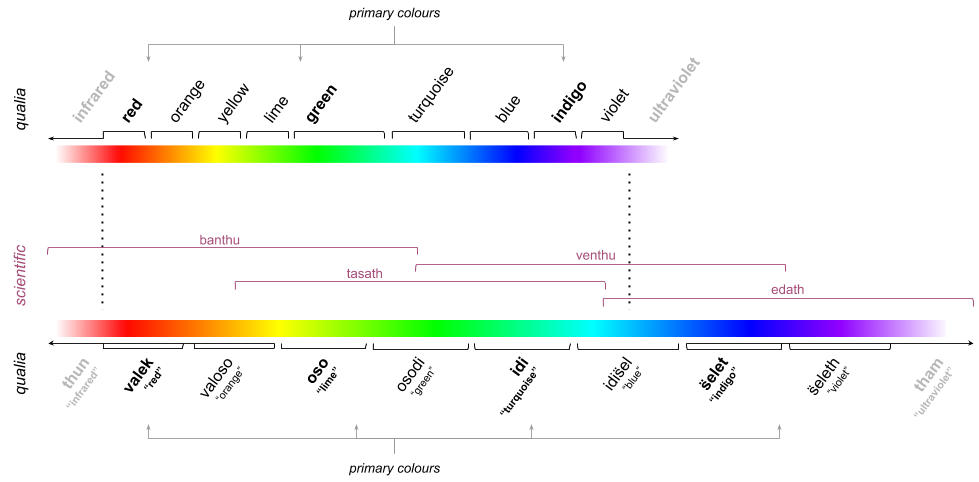This is an old revision of the document!
Table of Contents
kavkem colour vision more closely resembles avian colour vision than it does human or mammalian colour vision.
Biological considerations
Where humans have three different colour cones unevenly spread across the electromagnetic spectrum (our 'red' and our 'green' have nearly identical absorption peaks - it's our brain that turns the absorption patterns into sensible qualia), birds have four different colour cones that are far more evenly spread.
Additionally, birds have visual impressions further into the ultraviolet end of electromagnetic spectrum.
This implies that kavkema have four fundamental colour impressions, whereas humans have only three.
Qualia
A quale is a subjective impression of colour. You may have heard of the philosophical musing “the mysterious redness of red” - here, “redness” is the quale, “red” is the physical phenomenon. Differently worded, “red” is an electromagnetic phenomenon involving photons with a wavelength somewhere between 625 and 740 nanometers, and “redness” is the vivid colour impression you have when this phenomenon interacts with your senses.
Qualia are important when you start to think of colours as a perceptive continuum. Indeed, as a human being, you might be inclined to place all colours on a colour wheel - but this isn't quite compatible with spectral colours. Physically speaking, <fc #ff0000>red</fc> does not wrap around to <fc #8800ff>violet</fc>. Where, then, is <fc #ff00ff>magenta</fc>? It's not a spectral colour.
The source of magenta (and even its logical necessity as a quale) can be found in our colour cones - red, green and blue.
When red cones and green cones both fire, we can assume that something on the spectral line between red and green struck our retina. We see yellow and can identify it as a spectral colour.
When green and blue cones both fire, we can assume that something on the spectral line between green and blue struck our retina. We see turquoise and can identify it as a spectral colour.
But what happens when red and blue cones fire, without that green also fires? That doesn't work - there isn't any physical stimulus of a single colour that would excite the red and blue cones without also exciting the green cone. We must be seeing a mixture of red and blue.
Let's stop for a moment to appreciate what this means for us. It means we can identify “a mixture of red and blue” as a separate sensation from “a spectral colour halfway between red and blue”. We've invented additional colours! These lie on the line of purples.
However, kavkema have four basic colour perceptions of spectral colours: Valek (red), oso (green), idi (violet) and s̈elet (ultraviolet).
Let's assume for the sake of simplicity that their spectral colour perception is the same as humans, only stretched, making valek correspond to our red quale, oso to our lime quale, idi to our turquoise quale and s̈elet to our violet quale:
The kavkema do not only have the line of purples - there are other dimensions to their colour perception! Here is a table of the combinations, their qualia, and their corresponding kavkemic Kendane͡ivash terms:
| valek | oso | idi | s̈elet | spectral | Kendane͡ivash | English (kavkem) | English (human) |
|---|---|---|---|---|---|---|---|
| x | yes | valek | red | red | |||
| x | yes | oso | lime | green | |||
| x | yes | idi | turquoise | blue | |||
| x | yes | s̈elet | indigo | ultraviolet; invisible | |||
| x | x | yes | valoso | orange | yellow | ||
| x | x | yes | osodi | green | turquoise | ||
| x | x | yes | idis̈el | blue | violet, beginnings of ultraviolet | ||
| x | x | no | vals̈et | magenta | red-ultraviolet; appears just red | ||
| x | x | x | no | ||||
| x | x | x | no | ||||
| x | x | no | sos̈et | green-violet | green-ultraviolet; appears just green | ||
| x | x | no | validi | red-turquoise | magenta |
We derive that there are three imaginary lines of colour, of which we can unfortunately only imagine one:
- Colours around vals̈et correspond in quale to our 'line of purples'.
- Colours around sos̈et have no human correspondence, but are best described as lying on 'the green-violet line'.
- Colours around validi also have no human correspondence, but are best described as lying on 'the red-turquoise line'.
You may have noticed that the table combined three distinct colour sensations into one colour quale:
| valek | oso | idi | s̈elet | spectral | Kendane͡ivash | English (kavkem) | English (human) |
|---|---|---|---|---|---|---|---|
| x | x | no | vals̈et | magenta | red-ultraviolet; appears just red | ||
| x | x | x | no | ||||
| x | x | x | no |
This is because the last two variants of vals̈et do not afford a greater semantic understanding - all three of these variants involve valek, s̈elet, and at least one absent spectral impression that would otherwise lie between them. These variants come with subjective impressions of a slightly shifted hue and lightness. We will revisit this phenomenon later.




